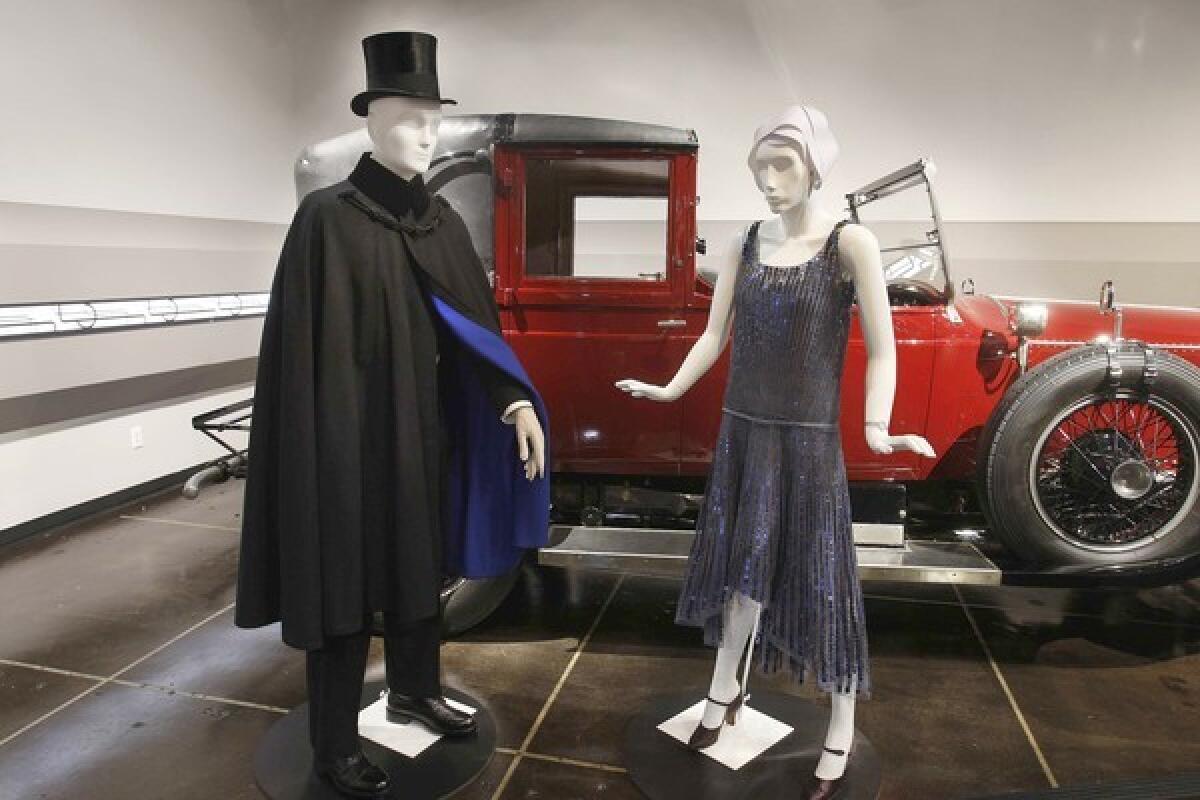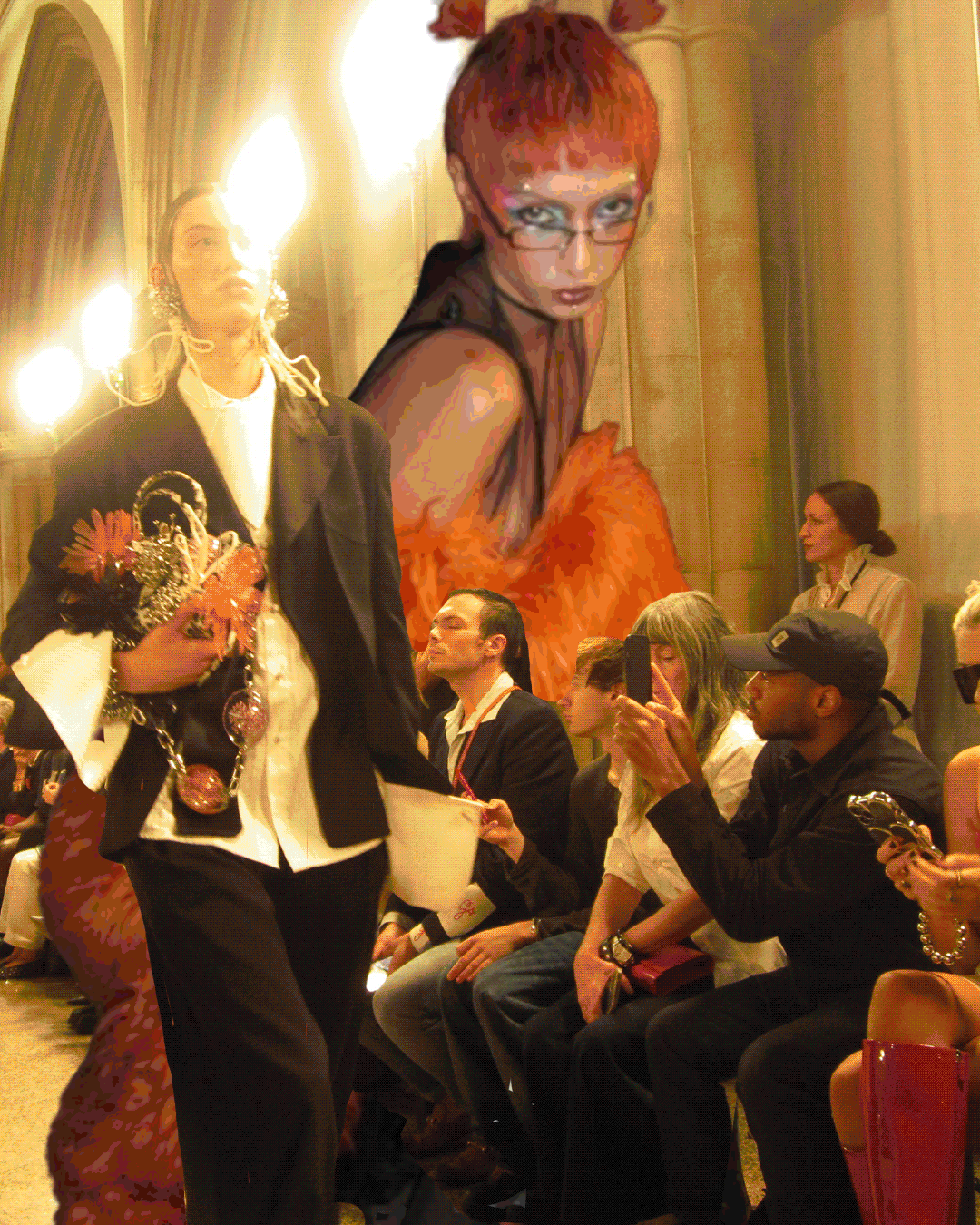Cars and fashion: An intertwined history

Car culture and the fashion world have a long, intertwined history, from the early motoring influences of Alfred Dunhill, who, in the early 1890s refocused his father’s saddlery business on the newfangled contraption (complete with the slogan “Everything but the motor”), to the artwork of 1970s’ era car customizer Kenny “Von Dutch” Howard, which helped spawn the trucker hat trend. But rather than trying to plot the entire roadmap, a new exhibit at the Petersen Automotive Museum focuses on one intersection in particular — the dawning decades of the car, when the twin fascinations with speed and motion literally shaped the look of both wheels and wardrobes.
Titled “Automotivated: Streamlined Fashion and Automobiles,” the compact exhibit features just eight autos (all but one from the Petersen’s own 300-vehicle holdings) juxtaposed with a handful of garments and accessories (on loan from the Phoenix Art Museum) in a way that illustrates how the emerging technology of the automobile influenced — and was reflected in — the wardrobe of the day.
“Cars and clothing are two of the most revealing things about a person,” the Petersen’s curator, Leslie Kendall, noted during a recent press preview of the exhibition. “Especially in L.A., where cars are almost like another layer of clothing you wear when you go out into the world.”
Despite Southern California’s fascination with the automobile, the current exhibition, which runs through Jan. 23, has a starting line about 400 miles east, in Phoenix.
That’s where, in 2007, the curator of fashion design at the Phoenix Art Museum, Dennita Sewell, found herself opening an early iteration of the “Automotivated” exhibit, highlighting the influence of cars on the fashion world, but relying on illustrations instead of the actual cars. At the same time, the museum was mounting another car-themed exhibition called “Curves of Steel: Streamlined Automobile Design,” which just so happened to include a car borrowed from the Petersen’s collection.
While she was giving Kendall a tour of both exhibitions, Sewell says the two started talking about the upside of showcasing the cars and the clothes side by side (an option Sewell says wasn’t possible at the Phoenix museum due to space constraints.) “Otherwise, it’s hard to visualize [the connection],” Kendall says. “This way, there’s context; each pairing highlights the similar constraints and influences both were going through.”
The result, after about a year of discussion and winnowing down the choices, is the Petersen’s exhibition of eight groupings that cover the period from 1913 to 1938. Like most trips, the most memorable parts of the exhibition are likely to be the beginning and end of the voyage, but the journey is so short, and the offerings so tightly edited, that it’s easy to navigate and hard to leave without learning a thing or two about the period.
The first car in the exhibition is a 1913 Mercer Type 35-J Raceabout (if you’re not conversant in car, at first glance, it looks kind of like Chitty Chitty Bang Bang minus the wings). The two-seater is open to the elements, with a gas pedal located on the exterior of the car and what Kendall describes as a “monocle windshield” — essentially a circle of glass barely larger than a dinner plate mounted atop the steering column just behind the steering wheel.
“In the early years of the car, with the exposure to dirt and dust and weather, you had to dress for the journey and not the destination,” Kendall said, “and the garments of the day weren’t adapted to automobile travel.”
The result was hardly high fashion — the accompanying garments are mostly floor-length dusters, beige and sun-bleached linen pieces that could easily be worn over the huge skirts of the day, including a 1909 linen duster from Marshall Inc., a circa 1910 silk pongee motoring coat with a printed silk collar, a 1927 raccoon fur coat with flannel linings and an assortment of goggles, netting veils and gloves.
The voyage makes a pit stop in the Roaring 20s, first to point out that the advent of the closed cab meant the journey was no longer the overriding wardrobe concern, and second to highlight how the aesthetic of the Art Deco movement (generally considered the years between the two world wars) was reflected in both fashion and motoring. On display is a rakish, linear 1923 Mercedes 28/95 Targa Florio, paired with a bold geometric print cotton rayon day dress circa 1926-27, and a 1927 Rolls-Royce Phantom I Town Landaulet by Hooper, paired with a 1920s black wool men’s Joseph Cipolari evening cape and the most quintessentially Art Deco style piece in the exhibit, a gorgeous, delicate, 1928 Gabrielle “Coco” Chanel dress in gray silk tulle with metal sequins.
If there’s a weak spot in the presentation, it’s in the grouping that touches on the early notions of streamlining, displaying a collection of foundation undergarments from the 1930s, including Lastex bras and girdles for women (Lastex was the trademarked name of a then new kind of yarn that wound rayon, nylon and silk around a rubber core and allowed the shift away from rigid corsets) and Und O Gird men’s boxers (proving that despite the recent hype, men’s shapewear is hardly a new phenomenon). The intention is to illustrate how the early notion of smoothing and streamlining was manifested in the use of new fabrics, but (and this is a testament to the success of the rest of the pairings in the exhibit) there seemed little to connect them to the 1937 Cord 812 Convertible Coupe with which they were displayed.
But it does set the groundwork for the remainder of the exhibit, which begins to fire on all cylinders when it starts to delve into the fascination with the notion of streamlining and simplicity that emerged in the 1930s, illustrated not only by the clothes and the cars but also by a collection of vintage Vogue magazine covers.
Two vehicles in the collection — and the clothes clustered around them — make the strongest connection between the coachbuilders and couturiers of the mid-1930s.
The first is a 1934 La Salle Series 350 Convertible Coupe designed by the legendary Harley Earl with round hood vents, a two-tier “biplane” bumper and a tall, slender front grille. It’s impossible not to see the same aesthetic at work in the 1930-31 silk chiffon Paquin evening coat with tiered, fur-trimmed sleeves and the 1939 printed silk Hattie Carnegie dress with circular cutouts.
The second is the last in the exhibit, a 1938 Delahaye 135M Roadster by Figoni et Falaschi, a black, gleaming body swept and smoothed like a piece of art work — or the feminine form itself — with enclosed wheels and headlights integrated into the fenders, and a fold-down split windshield, and a minimalist red stripe ribboning along the body (apparently only 10 such cars were ever built, and only three are known to survive; this one was found under an olive tree in the Algerian mountains in 1992). Standing next to the Delahaye is an equally simple and elegant Jeanne Lanvin day ensemble from 1937, consisting of a black wool dress, dickey, belt, cape, hat and gloves, also with the most minimal of ornamentation: four gold buttons down the front, and a single yellow band on the hat.
It’s hard to leave the “Automotivated” exhibit without wondering whether there’s any invention of the modern era that’s shaped — and reflected — the look of our wardrobes as much as the car did in its first four decades. Or perhaps our a la carte, always on, speed-of-light existence has foreclosed the possibility that anything will ever capture our attention as completely, dooming us instead to endless mini-cycles of “Free Lindsay” T-shirts, iPad-pocket jackets and fast-fashion collaborations.
Will anything, a century from now, resonate in fashion the way the car did last century?
“It’s hard to think of something that’s had as important an effect on our lives today as the Internet,” said Sewell, “and we know it’s something that fashion designers have really taken into account. But will the Internet end up having the same kind of profound effect as the automobile? We won’t really know that until we have the benefit of hindsight.”
Sounds like the answer will have to wait until the “World Wide Wardrobe” exhibit circa 2110, which will probably be available streamed as a holograph to the dashboard viewing pod of a run-of-the-mill flying car.







